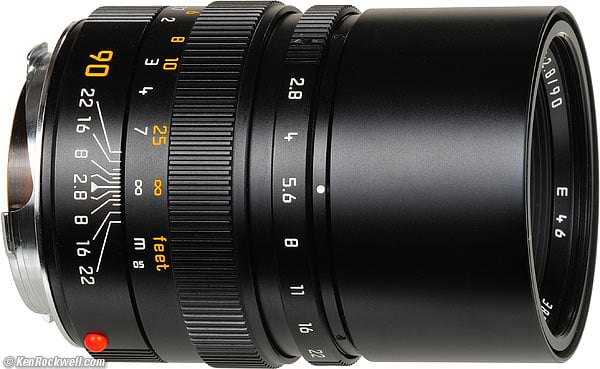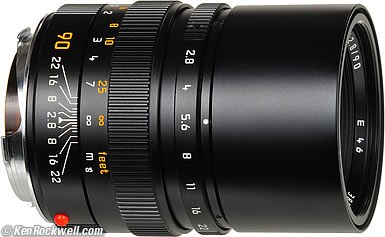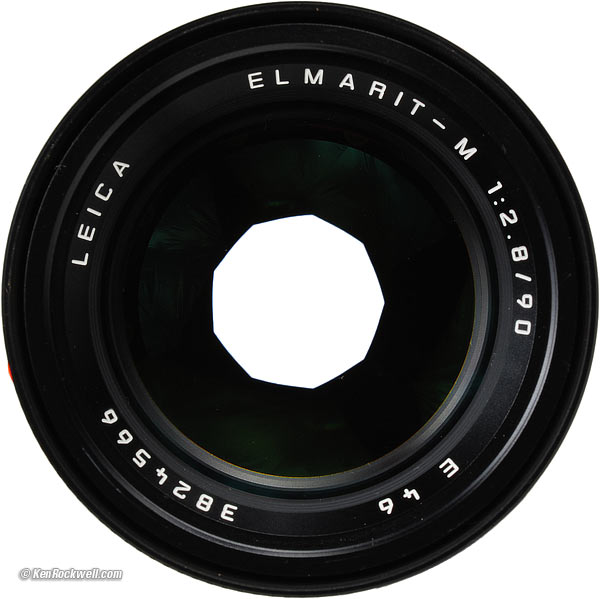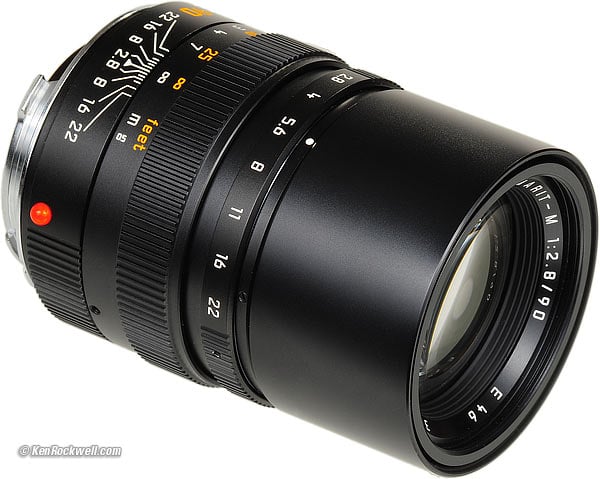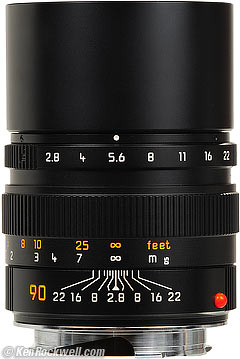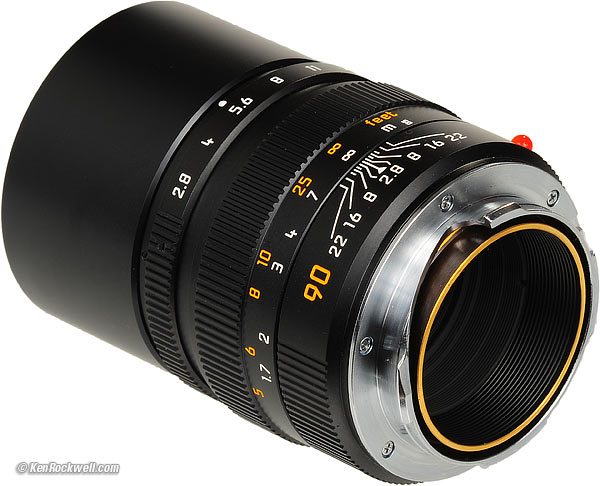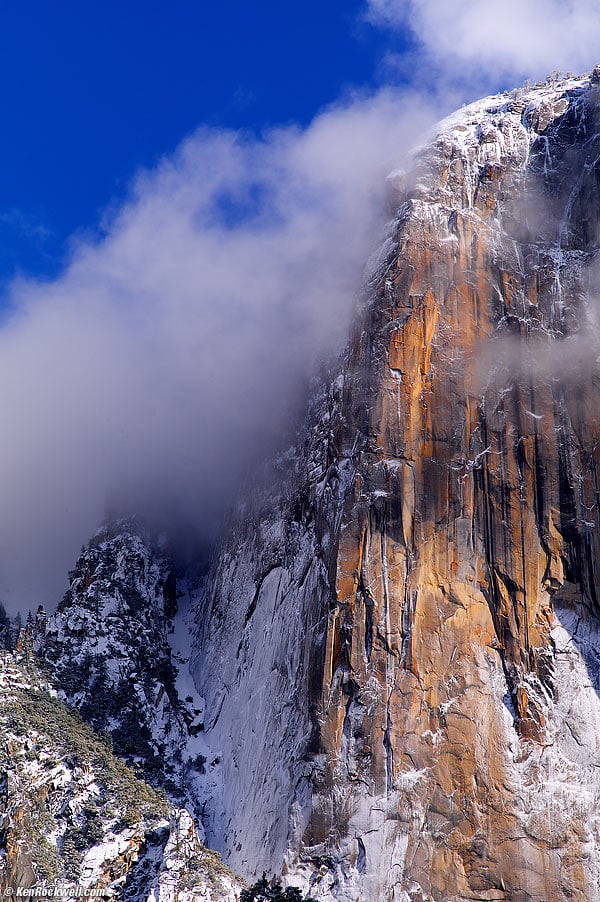Home Donate New Search Gallery How-To Books Links Workshops About Contact
LEICA 90mm f/2.8
ELMARIT-M (1990-2008)
© 2010 KenRockwell.com. This page best with Corporate S regular and bold activated.
Intro Specs Performance Usage Compared Recommendations
Leica 90mm f/2.8 Elmarit-M (46mm filter, 13.940 oz./395.15g). enlarge. I got this one at this link to it at eBay; Adorama and Amazon also sell them. It helps me keep adding to this site when you get yours from these links, thanks!
November 2010 Leica 90mm f/2.8 Lenses Compared
Leica Camera Reviews Leica Lens Reviews Recommended Lenses
Leica Lens Names How to Afford Anything
Sample Images:
Yosemite in Winter February 2011 (scroll down to color)
Full-resolution 8MB © JPG from DNG.
| Optics: | |
| Mechanics: | |
| Ergonomics: | |
| Usefulness: | |
| Availability: | |
| Overall: |
Ideal Uses
This is the only Leica tele you might ever need. This 90mm f/2.8 Elmarit-M is optically perfect, but it's bigger and heavier than the previous 90mm f/2.8 Tele-Elmarit-M (1974-1990).
Not for
Today's LEICAMAN demands nothing less than the best, which is the 90mm f/2 APO ASPH (55mm filter, 16.675 oz./472.77g), but it is bigger and weighs more than this superb 90mm f/2.8. The optics of this f/2.8 are unsurpassed, however the f/2 APO ASPH doesn't weigh that much more for an extra stop, and price is never an issue to the LEICAMAN.
Introduction top
Intro Specs Performance Usage Compared Recommendations
|
I personally buy from Adorama, Amazon, Ritz, B&H, Calumet and J&R. I can't vouch for ads below.
|
The Leica Elmarit-M 90mm f/2.8 is optically perfect.
The Leica 90/2.8 is ultra-sharp even wide-open in the corners, and has no distortion or ghosts.
This Leica 90mm f/2.8 sold for up to $2,000 when new in 2008, and was a bargain used in 2009 before the LEICA M9 arrived, selling for only about $650 over eBay. In 2010, the computer toward caught up and bought LEICA M9s, so the used price has doubled at the end of 2010 to about $1,100 over eBay.
This Leica 90mm f/2.8 Elmarit-M is unsurpassed in 35mm photography both for image quality, as well as superb handling and ergonomics.
Other lenses, like the cheap Leica 90/2.5 Summarit-M, exotic Leica 90mm f/2 APO-Summicron-M ASPH and Zeiss-for-Contax 90mm f/2.8 Sonnar are as good optically. 90mm f/2.8 lenses are not difficult to design.
The only way to get sharper images than with this 90mm lens is to step up to a larger format, like a Pentax 645N and Pentax 150mm lens, which makes superior images and costs only a fraction as much as Leica, but is a huge freaking handful of a camera system by comparison.
See my Leica 90mm f/2.8 Lenses Compared for a run-down of all the various 90mm f/2.8 and f/2.5 lenses made for the past five decades, all of which you easily can buy used and all of which are perfectly compatible with the entire Leica M system.
Actual Size introduction top
Presuming you have a standard 106 DPI monitor, this is its actual size, which is 3.263" (82.89mm) overall:
Leica 90/2.8 Elmarit-M, actual size. enlarge.
The illustrations in this review have been enlarged to fit the page.
History introduction top
See Leica 90mm f/2.8 Lenses Compared.
Specifications with commentary top
Intro Specs Performance Usage Compared Recommendations
Name Focal Length Angle-of-View Optics Diaphragm
Filter Thread Close Focus Case Caps Hood
Size Weight Colors Part Numbers Price
Name specifications top
Leica calls this the LEICA ELMARIT-M 90mm f/2.8, model number 11 807.
Elmarit means nothing except a Leica-brand f/2.8 lens.
M means it fits the eternal M series of Leica rangefinder cameras, as well as the Voigtländer Bessas, Zeiss Ikons and Minolta CLE.
Focal Length specifications top
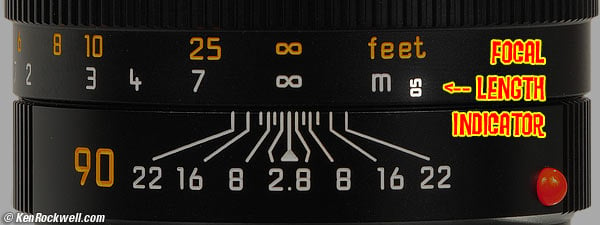
Focus Scale, Leica 90mm f/2.8 Elmarit-M.
Actual (design) Focal Length: 90.0mm.
The actual focal length will vary with production tolerances.
To compute the exact actual focal length of your lens, use the two digits shown to the right of the "m" on your focus scale as millimeters and tenths.
For instance, the lens shown here has a mystery number of 05, meaning the real focal length is 90.5mm.
Equivalent on the Leica M8 (half-frame): 120mm.
Equivalent on the Epson R-D1x (half-frame): 135mm.
Angle of View (full-frame 35mm) specifications top
27º Diagonal.
23º Horizontal.
15º Vertical.
(less on lesser formats.)
Optics specifications top
4 elements in 4 groups.
Multi coated.
Diaphragm specifications top
Leica 90mm f/2.8 Elmarit-M at f/5.6. enlarge.
9 blades.
Stops down to f/22 with half-stop clicks.
Blades are straight, except for being slightly S-shaped at f/3.4, and eerily circular at f/22.
Filter Thread specifications top
46mm.
Germans call this E46 and 46E, but it's the same standard 46mm (0.75mm pitch) filter that's available everywhere.
Close Focus specifications top
Marked: 3.5 feet and 1 meter.
It actually focuses a bit closer.
Case specifications top
Leica's soft nappa leather case, part number 439-606.044-000, is included.
Caps specifications top
Any 46mm snap-on front cap works great.
Leica's current part number for their 46mm snap-on is 14 231, which sells for $30.
The clever thing about the Leica cap is that it has a broad lip so that you can't extend the hood without remembering to remove the cap first.
The rear cap is the standard 14 269, $27 if lost.
Hood specifications top
There is a built-in telescoping hood, yay!
Size specifications top
I measure 2.168" diameter x 2.990" extension from flange (55.07 x 75.94mm).
I measure 3.263" (82.89mm) overall, including the bayonet mount.
Weight specifications top
I measure 13.940 oz. or 395.15g.
The chromed brass version was specified at 560g (19-3/4 oz.).
Colors specifications top
The Leica 90mm f/2.8 has always been a very popular lens, and therefore Leica sold it in at least three colors.
I show black here.
Leica also made it in chromed brass, and even painted some lenses with titanium-coloered paint.
Product Numbers specifications top
Black Anodized Aluminum Lens, complete: 11 807: Includes boxed lens, leather case, caps and paperwork.
Chromed Brass Lens, complete: 11 808: Includes boxed lens, leather case, caps and paperwork.
Titanium-Painted Aluminum Lens, complete: 11 899: Includes boxed lens, leather case, caps and paperwork.
46mm Front Cap (replacement): 14 231 ($30).
Rear Cap (replacement)): 14 269 ($27).
Case (replacement): 439-606.044-000.
Price specifications top
2010, November, USA: Sells for about $1,100 in great condition at eBay. The other colors sell for about $1,400, but some people will ask even more, but not expect to get that price.
2009, May, USA: Sells for about $650 in great condition at eBay; dealers like Adorama typically ask around $1,200.
It sold new for $2,000 in 2008, and Leica offered a $300 rebate at the end of 2008.
Leica 90 2.8 ELMARIT-M. enlarge.
Performance top
Intro Specs Performance Usage Compared Recommendations
Overall Aperture Ring Bokeh Coma Depth-of-Field Scale
Diaphragm Linearity Distortion Ergonomics Falloff Filters
Finder Blockage Focus Lateral Color Mechanics Sharpness
Overall performance top
This Leica 90mm f/2.8 is sharp and contrasty, even at f/2.8.
It handles great, and the price is right.
Your biggest limitation to sharpness is the simple fact that most samples of Leica and other rangefinder cameras have rangefinders that are not perfectly adjusted, meaning you will probably need to have your dealer (no, not you or a friend) professionally adjust your camera for optimum focus with your sample of lens.
Aperture Ring performance top
The aperture ring is perfect, like most current Leica lenses.
One fingertip is all you need to adjust it by feel.
Bokeh performance top
Bokeh is the character of out-of-focus areas, not simply how far out of focus they are.
The Leica 90mm f/2.8 Elmarit-M has neutral to good bokeh for out-of-focus backgrounds, which is great.
Coma performance top
This Leitz 90mm f/2.8 Elmarit has no coma. Coma is when points of light in the corners grow into weird-shaped blobs.
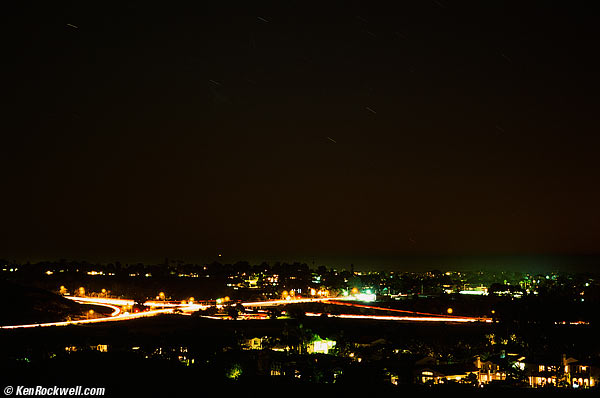
Full image, f/2.8. Leica 90mm on Fuji Velvia 50, 128 seconds at f/2.8.
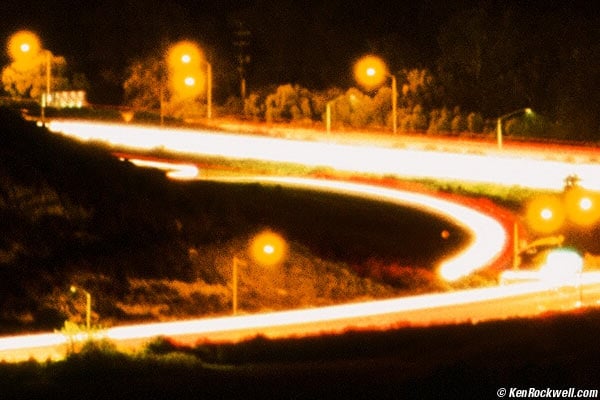
Crop from lower left of above 3600 DPI scan at 100%.
This is a crop from an 0.17" x 0.11" (4.2 x 2.8mm) section of the image. If the entire image was shown at this magnification, it would be a 32" x 48" print!
Depth-of-Field Scale performance top
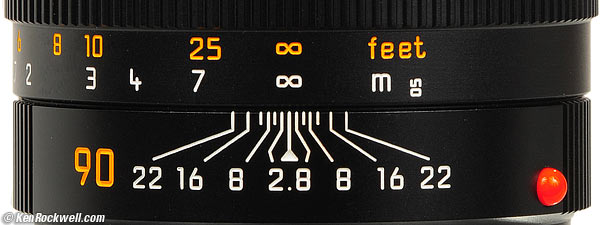
Depth of Field Scale, Leica 90mm f/2.8 Elmarit-M.
The depth of field scale is tight.
The 90mm f/2 APO has a far more useful scale, because it's a bigger lens.
Diaphragm Linearity performance top
My M7 agreed exactly as I tried every half-stop.
This shows a well-made lens.
It's not important when using TTL exposure meters, as with most modern cameras, but is important if you're using an external meter.
Distortion performance top
Distortion is invisible.
For critical use, use these values in Photoshop's Lens Distortion Filter to correct the invisible f pincushion (sucking) distortion:
35mm Film |
|
∞ |
-0.5 |
30' (10m) |
tbd |
10' (3m) |
tbd |
3' (1m) |
tbd |
© 2009 KenRockwell.com. All rights reserved.
Ergonomics performance top
Leica 90/2.8 Elmarit-M (actual size at 106 DPI). enlarge.
Ergonomics are perfect.
The aperture flicks with a fingertip.
Focus takes only one finger tip, but I usually use two fingers for precision.
Focus is about the same as other 90mm lenses. Close-focus comes up with a 160º rotation of the focus ring.
The grip on the rectangularly-knurled focus and aperture rings is perfect. Grip is great, and never mushy or lumpy like rubber.
Falloff (darkened corners) performance top
Falloff is minor at f/2.8, and gone by f/4.
This is as expected for a short tele.
Per Leica's data (page 69), falloff is 0.95 stops at f/2.8, 1/3 of a stop at f/4 and 1/6 of a stop at f/5.6.
The falloff is very gradual, and therefore invisible and probably compositionally beneficial. It's not a sudden drop-off as in the 90mm f/4 Elmar-C at f/4.
Filters, use with performance top
Any 46mm filter works great. You can even stack a couple with no problem.
Finder Blockage performance top
A disadvantage of the larger size of this 90mm f/2.8 Elmarit-M compared to older versions like the 90mm f/2.8 Tele-Elmarit-M is that it can block the finder a little, especially at close distances and with the hood extended.
On the LEICA M7, LEICA M6 and M4-P
Little to moderate blockage with the hood extended.
Little to none with the hood retracted.
On the Leica M3
Negligible to moderate with the hood extended.
None with the hood retracted and focused farther than 10 feet (3m), a little bit with the hood down and closer than 10 feet.
On the modern Zeiss Ikon
None to minor with the hood out.
None with the hood retracted and farther than 4 feet (1.2m), a little bit with the hood retracted and closer than 4 feet. Warning: The Zeiss only has framelines for 85mm, not 90mm. I'm looking at the 85mm frame line.
On a Minolta CLE
None at any distance with the hood retracted. Just a little blockage focused closer than 5 feet (1.2m) with the hood extended. Be careful; your CLE may or may not offer focusing precise, repeatably or accurate enough for your taste with any 90mm f/2.8 lens.
Focus Accuracy performance top
One of the weakest things about rangefinder cameras is getting precise and accurate focus with long lenses.
Most rangefinder cameras I see, regardless of being Leica, Zeiss, Mamiya, Nikon, Canon or Minolta, need their rangefinders adjusted by a pro to get them perfectly in line.
Every body and sample of this lens I've tried gives different results, if you expect perfect focus at f/2.8 every time.
You'll have to try your sample for yourself, and be sure to keep your camera well tuned by your serviceman. Even if it's OK this week, next week it can drift.
Most people never notice this, since most people aren't as picky as I am and most people shoot stopped down.
Lateral Color Fringes performance top
None visible, at 40x magnification.
Mechanics and Construction performance top
Rear, Leica 90/2.8 ELMARIT-M. enlarge.
The Leica 90mm f/2.8 ELMARIT-M is made exactly like every other real Leica M lens, which is superbly. (The cheaper Leica 90mm f/2.5 Summarit-M lens is inferior mechanically; I'm excluding that lens from consideration here as not a real Leica lens because it is not the best. If it is not the best, it is not Leica.)
This Elmarit-M lens is made to last far beyond any of our life times. My 55-year old Leica lenses still work like new, and this recent Leica 90mm lens will be going long after I'm dead.
Hood: Sliding anodized aluminum. Ribbed interior painted matte black.
Barrel: Black anodized aluminum.
Focus Ring: Black anodized aluminum.
Focus Tab: None.
Aperture Ring: Black anodized aluminum.
Focus Helicoids: Brass.
Other Internals: Metal.
Mount: Dull chromed brass.
Mounting Index Dot: Red plastic ball.
Markings: Engraved and filled with paint.
Quality: Made in Germany.
Sharpness performance top
Monolith, Yosemite. Full-resolution 8MB © JPG from DNG.
This Leica 90mm f/2.8 lens is sharp, sharp, sharp. I can't make it unsharp even with my most devious tests, which can make otherwise great lenses look awful for the purposes of testing.
If you're not getting sharp results, it's because you're not a good photographer or your rangefinder is out of adjustment. I can't make this 90mm lens make a soft image.
You can't check sharpness with color prints. You have to shoot B&W or Fuji Velvia 50 and look at it under high magnification (equivalent to at least 30 x 40" prints) to see anything meaningful. I shoot Velvia 50 and look at it at 40x magnification. I was always amused by Leicaphiles who thought they could see sharpness in 5x7" machine prints — you can't. When I'm discussing sharpness, I'm looking at prints over four feet (120cm) wide.
Compared directly to the world-leading 90mm f/2 APO APSH, it's the same. The reason you pay more for the APO ASPH is because it opens an additional stop and stays stays just as sharp, even at f/2. I suppose I could force the issue and somehow see some slight supremacy in the APO ASPH only at f/2.8; but who cares: if anyone needs higher quality, a larger film format is required.
How do you check focus? Go make a bunch of shots at f/2.8 at various distances and check that the resulting images are focused exactly on your intended subject.
Sunstars performance top
The 9-bladed diaphragm begets symmetrical 18-pointed stars.
Usage top
Intro Specs Performance Usage Compared Recommendations
Focus Film Flatness Optimum Aperture Minolta CLE
This lens is super-easy to use. The biggest potential issue, as with all rangefinder cameras with long lenses, is to be sure you're getting focus good enough to do this great lens justice.
As covered above, the first thing you must do is shoot some film at f/2.8 to confirm that your lens is well matched to your camera's rangefinder.
Take pictures at f/2.8, and be sure the optimum focus falls exactly where you intend, not a few inches ahead or behind.
Even if you've gotten perfect results with a fast 50mm lens, your camera could still be off enough to rob you of the sharpness of which this 90mm lens is capable.
Long lenses are far more demanding of mechanical calibration accuracy than 50mm and shorter lenses.
To make things worse, different cameras will give different results with different samples and versions of lenses. If you try to get all your lenses and cameras to work perfectly, you'll go crazy. On my cameras, I test them all on film and know which bodies and lenses work well together. Sorry, this is a limitation of the rangefinder system, which is superb for wide lenses but poor for long lenses.
Be careful: if your film has sat overnight, as you wind to the next frame you may have a slight kink in the film from where it sat on the edge of the spool. This often leads to having a slight lack of flatness for the next frame.
This subtlety happens in most cameras; I haven't specifically seen it in Leica, but if you're checking focus accuracy, be aware that this can throw a frame off.
Leica tells us that f/5.6 is optimum, but I honestly cant' see any significant variation in sharpness at f/2.8 compared to f/5.6. It's easy to show on MTF curves, but very difficult to see on film.
The optimum aperture only applies if your subject is completely flat, or entirely at infinity.
For real photographs, stop down as needed for depth-of-field.
If your subject is flat, it's probably going to be a boring photograph anyway.
Diffraction limits the sharpness of all lenses at smaller apertures.
Use on the Minolta CLE usage top
Try yours yourself. My 90/2.8 ELMARIT-M focuses swell on my Minolta CLE.
Be careful: the smaller rangefinder base along with the fact that rangefinder cameras are pushing it for precise focus with long lenses means that you might not always get perfect results shooting at f/2.8. This isn't the lens, it's a limitation of rangefinder cameras.
Compared to other 90mm lenses top
Intro Specs Performance Usage Compared Recommendations
See also my Comparison of Leica 90mm f/2.8 Lenses.
90/2.8 Elmarit-M |
90/2 Summicron-M |
||||
| Produced | 1990-2008 |
1998 - |
2008 - |
1974-1990 |
1980-1998 |
| Optics | 4/4 |
5/5 ASPH |
5/4 |
4/4 |
5/4 |
| Filter thread | 46mm |
55mm |
46mm |
39mm |
49mm, 55mm |
| Length | 75.9mm |
77.3mm |
66.5mm |
61.3mm |
63.7mm, 77mm |
| Weight (actual) | 395g |
475g |
345g |
226g |
410g, 460g |
| Diaphragm Blades | 9 |
11 |
11 |
10 |
11 |
| Minimum Aperture | f/22 |
f/16 |
f/16 |
f/16 |
f/16 |
| Made in | Germany |
Germany |
Germany |
Canada, later Germany |
Canada |
| Sharpness* | Fantastic |
Extraordinary |
Fantastic |
Very Good |
|
| Price (5/09, USA) | $2,000 ($700 used) |
$400 used |
$600 used |
* Your camera's rangefinder calibration is going to make more of a difference in sharpness than the difference among these lenses. If, and only if, you got a perfectly adjusted system will you be able to notice any differences.
Recommendations top
Intro Specs Performance Usage Compared Recommendations
This is a great lens, but since I also have access to the bigger, faster 90mm f/2 APO ASPH and the tiny 90mm f/2.8 Tele-Elmarit-M, I never use this f/2.8 Elmarit-M.
I prefer the f/2.8 Tele-Elmarit-M for its far smaller size and weight. If I need the speed or ultimate image quality at f/4 and f/2.8, I just grab the 90mm f/2 APO ASPH because it isn't much larger or heavier than this 90mm f/2.8 Elmarit-M.
If I only got to pick one 90mm lens and cared about price, this 90mm f/2.8 Elmarit-M might be it.
The reason to pick this 90mm f/2.8 Elmarit-M lens is if you prefer the 46mm filter size over 39mm (tele) or 55mm (f/2 APO ASPH), and if you don't mind the extra size and weight over the Tele-Elmarit-M. If you don't mind the size and are picky about sharpness, this f/2.8 Elmarit-M is superior to the Tele-Elmarit-M at f/2.8 and f/4.
Leica discontinued this classic because the Leica Man simply buys the newer 90mm f/2 APO ASPH because it's not that much bigger or heavier than this f/2.8. The Leica man cares not the price; he cares only for the best. If you do fret the price, this used f/2.8 costs about $650 compared to $3,500 for a new f/2, and they work exactly as well optically and mechanically.
Forget this lens' replacement, the current 90mm f/2.5 Summarit-M. The Summarit-M is of inferior construction quality and not likely to hold its value over the decades, making the Summarit-M a more expensive proposition than it seems. Invest in the best, like a superior used Leica lens, and it won't cost you anything over time. The optics of the Summarit-M are fantastically good; it's the sloppy focus mount about which I complain.
The f/2.8 Elmarit-M has been the same lens since 1990. When buying, don't worry about age or serial numbers. Newer ones may be six-bit coded for the M8, but not to worry, since Leica can code old lenses for about $100 - $150.
If you need to buy new, look around since some dealers may have old stock.
Deployment
Leica 90/2.8 with caps (actual size at 106 DPI). enlarge.
I'd leave the leather case and $30 Leica front cap in the safe deposit box for resale time.
I'd use a 46mm 81A B+W brand filter for slide film.
I'd use any 46mm B+W brand yellow filter for B&W film outdoors or a 46mm Leica brand UV filter indoors.
I'd use a 46mm Leica brand UV filter 13 004 for color print film, but why would anyone shoot color print film in a Leica?
I wouldn't bother with a digital Leica until they come out with a full-frame body, and even then film is more fun, but that's just me. I'm told digital shooters today need to use a Leica brand 46mm UV/IR filter 13 411 (or a B+W brand 46mm UV/IR filter) to correct for a design flaw in the M8.2's sensor system design.
More Information:
Leica's Technical Data (pages 64-79)
PLUG
I support my growing family through this website.
If you find this as helpful as a book you might have had to buy or a workshop you may have had to take, feel free to help me continue helping everyone.
If you've gotten your gear through one of my links or helped otherwise, you're family. It's great people like you who allow me to keep adding to this site full-time. Thanks!
If you haven't helped yet, please do, and consider helping me with a gift of $5.00.
The biggest help is when you use any of these links when you get anything. It costs you nothing, and is this site's, and thus my family's, biggest source of support. These places always have the best prices and service, which is why I've used them since before this website existed. I recommend them all personally.
Thanks for reading!
Ken
Home Donate New Search Gallery How-To Books Links Workshops About Contact

